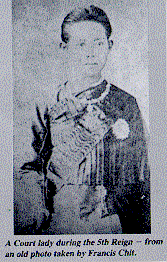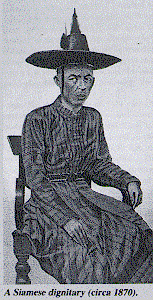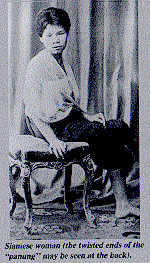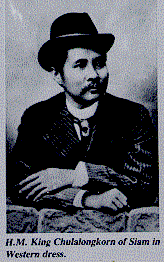
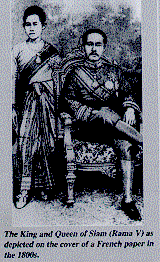
- Thai Dress Through The Ages
- The true origin and probable migration of the Thai people has been a mystery for anthropologists and historians for a very long time; and while some are quite positive of their conclusions, others still disagree. The several Thai tribes originated in the Ukthai Mountains of northern China more than 4,500 years ago. They migrated to southern China between the 3rd century B.C. and 5th century A.D. The Thai Ailao were horsemen who,
whenriding through jungles and rough terrain, needed protective clothing such as high-necked, long-sleeved jackets and long trousers which fitted tightly at the ankles. They also wore plain, simple metal jewellery -- but this may well have been the family bank-roll rather than ornamentation.
- Chinese Annals from about the 6th to 13th centuries say that the Thais dyed their cloth and "used geometric patterns." The women discarded their trousers and adopted a long skirt of pasin which was worn with a short overskirt resembling a peplum. They also began decorating their jeckets.
- Men's fashions also changed. The horsemen wore sleeveless, embossed leather shirts, leather belts and trousers with the seat covered with tapir skin. Officials, according to rank, wore tiger skin capes and cummerbunds of many colors which were often embroidered, and edged with gold. From the 9th to 13th centuries there was peace, and dress became very ornate.
- In the middle of the 13th century the hordes of Kublai Khan brought the destruction and devastation of burning and pillaging to the settlements. Those who were not killed or taken captive, migrated again -- this time farther south.
- The tracing of the evolution of Thai costumes has often been made possible by archeological discoveries of sculptures, chiselled terra-cotta stabs and temple decorations. Many bas-reliefs demonstrate dances and entertainments of the period of constrution, as well as the costumes worn at the time. Clothing of the Dvaravati Period reflects the Indian influence.
Women wore the sabai as the upper garment; the pa-nug, the lower garment, was a one piece cloth wrapped around the body from hips to mid-calf, with pleats at the front. Both men and women wore their hair long, in a variety of arrangements.
|
Top
|
|
Return to the main page
|




